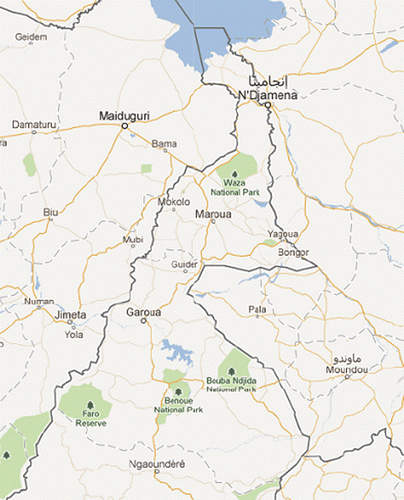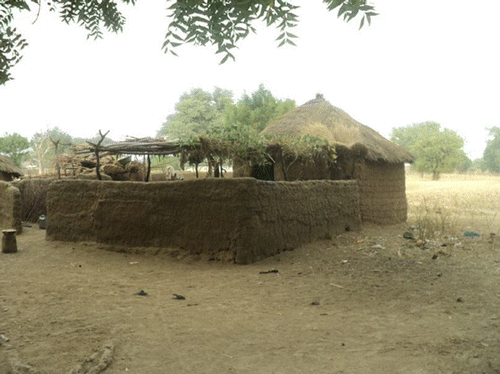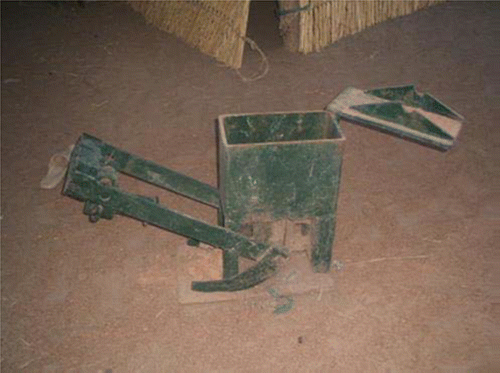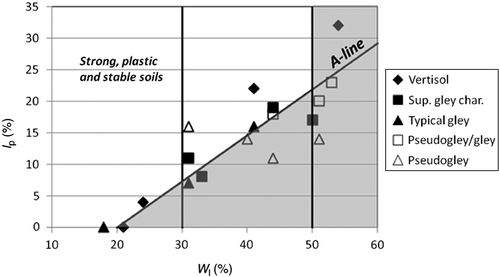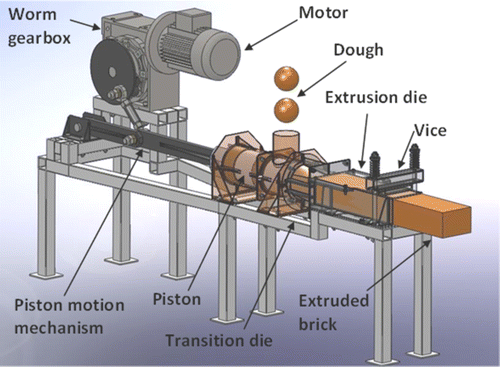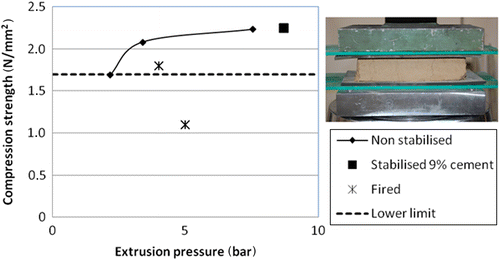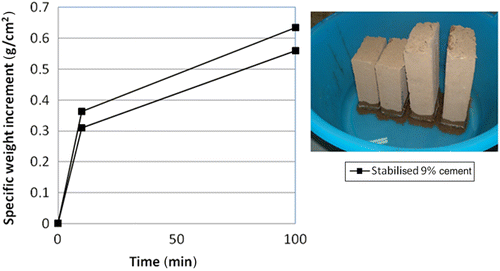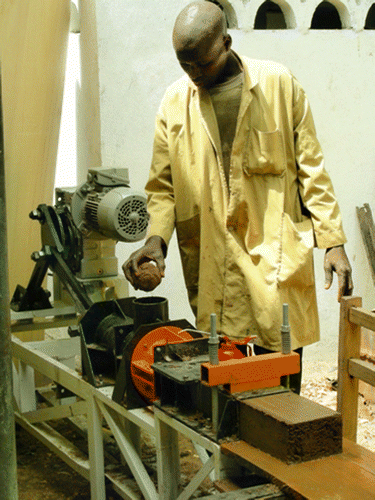Abstract
Deforestation is one of the most dramatic threats to environmental equilibrium and food safety in many regions of the world, and particularly in sub-Saharan Africa. It is enhanced by many kinds of human activities, among which is the earth brick-firing process that needs large amounts of wood for attaining and maintaining temperatures required during this process. In order to reduce deforestation, the present study investigated from different points of view the potential of crude earth to be used as building material, taking as a case study the Logone Valley located at the border between Chad and Cameroon. First, an on-site investigation was made to verify the state-of-the-art of brick production technologies and to evaluate their impact on the environment. Subsequently, morphological and geotechnical analyses on soil samples collected from different sites of the Logone Valley were carried out, to evaluate their suitability to brick production. Finally, a pilot plant for crude earthen brick production was set, particularly based on a new press designed for this purpose.
Introduction
Forests are a crucial factor in preserving the vitality of the environment and human life. They are the main means of storing carbon, protecting from climate change impacts and preserving biodiversity. Furthermore, in many regions, forests are designated for soil and water conservation, avalanche control, sand dune stabilisation, rain regularisation, desertification control and coastal protection (FAO Citation2010; Garcia-Carreras and Parker Citation2011).
In the last decade, although the global deforestation rate has shown signs of decrease, and in some continents (mainly Europe and Eastern Asia), the total forest surface has increased, in other regions, such as South America, Africa and Oceania, deforestation is still a matter of concern, as a net forest loss has been registered with increasing rates when compared with that reported in the previous decade. It is also a major source of economic and social harmful effects, such as the lack of food and wood for domestic use as a consequence of soil deterioration and rainfall irregularity (Myers Citation1989; Fall Citation2004; Samboré Citation2004; FAO Citation2010).
In particular, since 1990–2010, the total forest surface has decreased by about 12% in Chad and 18% in Cameroon, mainly due to wood exploitation as fuel for both domestic and handicraft purposes (FAO Citation2010). Among these activities, the use of wood as fuel for earth brick firing is an increasingly important part of the total wood exploitation (UNEP Citation2008; Alam and Starr Citation2009). Different techniques have been used in African countries for fired brick production at the handicraft level; however, in general, they are very inefficient and fuel consuming (Alam and Starr Citation2009).
Fired earthen bricks are replacing the traditional crude earthen ones as building material in all regions of Africa. This trend is not only due to the fact that fired bricks are more resistant to deterioration by atmospheric agents (mainly rain), but also because crude earth is perceived as ‘poor’ material in contraposition to the modernity associated with fired earthen bricks (Steyn and Bosman Citation2010). However, there are many reasons for valorising crude earth technology, among which the main reason is energy saving: producing 1 m3 of concrete consumes 1.0–1.8 MJ, whereas the same amount of raw earth for building consumes only 1% of this quantity of energy (Gerneke Citation1992). Other benefits of crude earth technology include the absence of carbon emissions, the reduction of environmental impacts related to building waste, low cost, raw material availability, the richness and variety of traditional knowledge on this construction technique. However, in order to obtain competitiveness of crude earth as building material, some innovations are necessary for obtaining a good product in terms of durability and reliability, aesthetics and cost.
In this context, the ‘Valrena’Footnote1 project was approved and funded by the European Union in 2009, within the ambit of the 9th European Development Fund. This project had the aim of promoting the sustainable exploitation of natural resources in the Logone Valley, along the frontier between Chad and Cameroon. Among the different activities planned in the project, the promotion of crude earth as building material that needs to be achieved by introducing an innovative production technology and setting up a pilot plant was included. This objective was pursued by taking into account the local context in terms of soil characteristics, social and economic factors, capabilities and technological resources.
In this paper, the main phases of project implementation and the results obtained are described. First, a survey on housing and building techniques in use in the Logone Valley was carried out, to identify features, problems and the possibility of improvement in earthen brick production at the handicraft level. Subsequently, an analysis of the morphological and geotechnical characteristics of local soils was also carried out, to evaluate their suitability to brick production and to identify the best locations for earth extraction. Then, a new extrusion press for improving crude earthen brick production was designed and tested, taking into account the local market features that emerged from the survey; the extruded bricks were tested and compared with the local traditional ones. Finally, a new machine was reproduced in a workshop in Cameroon and loaned to a local brick producer, to verify economic and environmental sustainability.
Survey on housing and building techniques in the Logone Valley
Table presents some general country indicators of Cameroon and Chad as well as some specific parameters related to urbanisation. In both countries, the population living in urban settlements is growing faster than that in rural areas, especially in Cameroon where urbanised people account for the majority of the total population. Both countries are characterised by a majority of the population living in poverty, with a dramatically worse condition in Chad. These data justify an increasing housing demand at an affordable cost for low-income families, especially in urban areas.
Table 1 Indicators of Cameroon and Chad.
The Logone Valley (Figure ) is located at the border between Chad and Cameroon, and is characterised by tropical climate with seasonal rainfall and a savannah–grassland landscape. The main cities in the region are the capital N'Djamena, Bongor and Mondou on the Chadian side (TD), and Yagoua, Maroua, Garoua and Ngaoundéré on the Cameroonian side (CM).
In March 2011 and subsequently in March 2012, two surveys were carried out in the region to obtain data about local needs related to house building. Several crude and fired brick production sites were found in the region, both at the household and handicraft levels. Crude bricks are used especially for building houses in rural villages (Figure ). Brick production is conditioned by the rainy season, when many crude earthen houses are damaged because of a twofold action: the walls are eroded by the impacting drops and the bottom part of the walls is weakened by the water absorbed from the ground as a result of flooding. Each year, at the end of the rainy season, new bricks are purchased at city markets for replacing the damaged ones; some people make bricks manually according to their own necessity, especially during lack of funds.
During the study, several manufacturers of fired and crude bricks were visited in the regions of N'Djamena, Bongor, Maroua and Yagoua. A single enterprise that produced non-fired bricks with sand and 5–10% cement was also contacted in the region of Maroua. Some information about the practice of brick making in the region was collected by conducting interviews with local producers, with the aim of depicting the state-of-the-art and understanding the context on which the project had to be developed. The information collected was considered as merely indicative, as local handicraft producers usually follow their practical experience rather than a standardised procedure, and the referred data were approximated. In general, the first phase of the process involving earthen brick production did not differ between the fired and crude ones: a dough of clay, sand and water, with the addition of vegetable fibres and/or animal dejections, is prepared. The percentage of different components varies according to local soil characteristics, material availability, manufacturer's experience and financial resources; just as a purely indicative datum, the following volumetric percentages of dry matter were recommended by a manufacturer of N'Djamena: 40% clay, 20% sand, 20% bovine dejections, 5% straw and 15% water; the straw composed of 30–50 cm-long fibres. The components are usually mixed on the ground by a shovel, by adding water gradually, until sufficient homogeneity is reached. Subsequently, the dough is covered by a waterproof plastic film and left for a couple of days, to allow uniform water penetration. Thereafter, the dough is formed through wooden moulds, giving the typical brick shape, and sun dried for 3 days (Figure (a)). The dimension of bricks also varies, with thickness ranging from 7.5 to 10 cm, width 15 to 20 cm and length 30 to 40 cm. After drying, they are ready to use as crude bricks; in the case of firing, they are stacked in a typical scove kiln structure (Figure (b)), with channels in the bottom region to be filled by a solid fuel; another fuel is also poured in the gaps between the bricks in the interior stack part, while the gaps are filled by dough in the exterior part to reduce heat dispersion. The solid fuel is also wetted by a liquid fuel (petrol or gasoline) to facilitate ignition. Once the fuel is fired up, combustion lasts for 3 days, with periodical fuel refilling. The production rate varies from 160 to 250 bricks per day, with the involvement of three to four employees.

Concerning production cost and selling price, different data were found according to the location and brick typology: the selling price of crude bricks ranged from 25 XAFFootnote2 (0.04 EUR) per item in Maroua (CM) to 40 XAF (0.06 EUR) per item in N'Djamena (TD); the fired brick price ranged from 60 XAF (0.09 EUR) per item in Bongor (TD) to 150 XAF (0.23 EUR) in Yagoua (CM); the sand–cement brick price was 175 XAF (0.27 EUR) per item in Maroua. The fuel cost in the production process varied from about 2 XAF (0.003 EUR) per item in the Cameroonian cities up to 17 XAF (0.025 EUR) per item in the Chad capital N'Djamena. This variation is due to the fact that in Chad, the production and commerce of charcoal has been forbidden since 2009 and, consequently, the price of other fuels rose up. In all cases of fired brick production, the wood cost ranged from 50% to 80% of the total fuel cost; other fuels used to integrate combustion included local tree nuts, animal dejections, petrol and charcoal (only in Cameroon). The wood consumption of the scove kiln can be estimated on the basis of the data published in the literature (ILO Citation1984; Greentech Knowledge Solutions, Enzen Global Solutions, University of Illinois, Clean Air Task Force Citation2012). It is about 0.16 kg of wood for 1 kg of fired bricks; therefore, given a dry brick density of about 1900 kg/m3, the environmental damage of a mean house comprising four rooms of 4 × 4 m each, with 30 cm thick and 3 m high walls, is about 13824 kg of wood. As harvesting data are usually given in m3, considering only the round-wood portion of the tree, a default wood density of 650 kg of dry matter per m3 (kg dm m− 3) (Dixon, Schroeder, and Winjum Citation1991) and a value of 1.90 for the total to round-wood tree volume (IPCC Citation1997) were considered, obtaining an environmental damage of about 11 m3 of round-wood portion of the tree per house.
These data show that the crude brick market should have many chances of expansion, both for economic and environmental reasons, provided that the problems of aesthetics and structural stability are solved. A way for improving crude brick quality is mechanising the production process, as machines can give adequate compaction and regular shape to the bricks; furthermore, binding agents (e.g. cement or lime) can be added to the dough to improve their resistance to water. Previous projects, that were aimed at promoting mechanised production of crude bricks, were also investigated. They were based on a manual press (Figure ) for brick forming and compacting, with the dough containing 6 to 12% cement. The working mechanism of the press is as follows: the quarterdeck has to be filled by the dough and covered at the top; subsequently, the dough is manually compressed through a lever system; after compaction, a mechanism lifts the brick outside the quarterdeck for brick removal. In all cases, it was concluded that the projects were not economically sustainable. In fact, the daily production and the number of employees were similar to those in the traditional procedure, but with higher costs due to the use of cement (which was 8000 XAF (12.20 EUR) per 50 kg) and to the initial investment for machine purchasing (about 250000 XAF (381.12 EUR)). These higher costs were not adequately compensated by an increment in brick quality, probably due to insufficient compaction pressure.
Morphological and geotechnical characterisation of clay materials from the Logone Valley
Morphological characterisation
To identify and describe the behaviour of clay materials from the Logone Valley, 32 soil samples were extracted using a Highway auger (diameter 500 mm), up to 6 m deep. In general, the clay materials tested were divided into four main groups (IRRI Citation1985; FAO Citation2006), based on their appearance:
Clay materials from vertisols: these soils are located at the edges of the stream in small depressions along the alluvial ridges (Grand Tougoudé), in the north of the Bongor plain near the major flow of flood waters of the Logone River and in the south of Yagoua (Datchéka). They have a depth ranging from about 3 to 6 m above the water table and are characterised by dark colour, clayey texture, massive structure, deep, open superficial desiccation cracks and micro-reliefs (gilgaï).
Clay materials from gley with vertisolic characteristics: this group of soil is further divided into two subgroups: soils with superficial gley characteristics and typical gley. Soils with superficial gley characteristics constitute a transition between vertisols and typical gley. They are mosaics of soil settling ponds, channels and distributaries in sandy clay materials. They are located in the north of Pouss, Guirvidig, Miogoye Bla, Tikem, Kalfou and Lokoro. Typical gley covers an extensive surface area of the Logone Valley, notably the lowest part of the flood plain. They are formed from alluvial clay materials settled in the area by the flood waters of the Logone River and its tributaries. They are located in Maga, Vélé, Dourang, Binga and Kim.
Clay materials from pseudogley and gley: they occupy the upper part of the flood plain and are formed from alluvial clay or sandy clayey materials. They are located in Bongor and Nahaïna.
Clay materials from pseudogley: they are present in the upper part of the sequence of clay materials in the valley, and vary from sandy clayey to clay loam deposits. They are located in Manga, Bongor and Gounou-Gaya.
Globally, the soils of the Logone Valley are characterised by three main horizons of clay materials: top surface horizon, which is dark grey to brown grey, sandy clayey to clayey, prismatic and plastic when wet; sub-surface horizon, which is grey to yellow brown, clayey to sandy clayey, plastic and prismatic with the presence of slickenside; and deep yellow-brown horizon, which is sandy clay, massive and somewhat plastic. Soil samples were collected from different horizons of each representative soil profile for laboratory analyses.
Geotechnical characterisation
Geotechnical analyses were performed in the laboratory of the Local Materials Promotion Authority (MIPROMALO) in Garoua (CM), to determine the behaviour of clay materials. In particular, these analyses included the measurement of the Atterberg plastic and liquid limits Wp and Wl, i.e. the water content W determining the transition from semi-solid to plastic behaviour, and from plastic to liquid behaviour, respectively. These limits were determined, respectively, by the roller method and the Casagrande liquid limit device. Subsequently, the plastic index Ip was obtained by the difference between the liquid and plastic limits (Ip = Wl − Wp). The testing method complied with the ASTM standard for this kind of analyses (ASTM Citation2010).
Table outlines the Atterberg limits of five soil samples, representative of the morphological groups listed above, at different horizons (depths). The plastic index ranged between 0 and 32: clay materials from vertisols exhibited the highest values, while materials from typical gley had the lowest values; in general, the sub-surface horizon exhibited higher values with respect to the top surface horizon. The plastic limit ranged from 0 to 37%: the highest values were observed in clay materials from pseudogley, while materials from vertisols exhibited the lowest values. The plastic limits of the top surface and sub-surface horizons were quite similar. Globally, the liquid limits were higher in the sub-surface horizon than in the top surface horizon. Again, clay materials from vertisols exhibited the highest values, while materials from typical gley had the lowest values. The same trend was observed for the water content.
Table 2 Atterberg limits of different horizons of some soils in the Logone Valley.
These data were summarised in the Casagrande chart (Casagrande Citation1948), which characterises the different soils depending on W and Ip (Figure ): the area above the inclined line (identified as ‘A-line’) and with Wl < 50% indicates the best soils for brick making due to high strength at the dry state and high plasticity and low dilatancy at the wet state. Vertisols and soils with superficial gley characteristics are in general the best within the soils analysed: therefore, the region between Yagoua (CM) and Bongor (TD), where these soils are prevalent, seems to be the most appropriate one for setting a plant for brick production.
Study of an appropriate technology for brick production
Design, prototyping and testing of a new press for earth extrusion
A new press for earth extrusion was designed and prototyped. Extrusion was chosen because it is a continuous process, allowing simultaneous dough feeding and brick compaction and removal, and without the stops required by block-pressing machines similar to the one shown in Figure . This allows for a more efficient and speedy production process, with the same number of employees. A scheme of the press is shown in Figure . The dough is inserted manually into the feeding opening; subsequently, a piston pushes the dough into the extruder, which in the initial stage has a transition die that changes the section shape from circular to rectangular. The resistant force allowing dough pressurisation near the piston head is due to the friction between the extruder wall and the dough during the flow. An elastic vice that pushes the flexible wall of the extruder near the exit allows pressure regulation. When the extruded dough reaches the right length, it is manually cut out and removed for drying. The piston is displaced by a mechanism composed by connecting rods, allowing the slowing down of the piston when it is in the extreme positions, to facilitate dough insertion and brick removal. The machine design was conceived in such a way that the fabrication of most components did not require machine tools with numeric control, so they can be produced in handicraft workshops of developing countries.
A prototype of the machine was first introduced at the University of Brescia (Italy), producing bricks of 5 cm in thickness and 10 cm in width; a 3 kW asynchronous three-phase motor was mounted with a worm gearbox, with the ratio being 1:100. Therefore, the piston run at about 15 cycles per minute, a sustainable speed for feeding and brick removal. The prototype was equipped with electronic instruments (inverter, load cell and computer control) to measure some running parameters, such as instantaneous piston velocity, compression force on the dough and consumed energy. Preliminary tests were carried out with a dough purchased from a German company producing crude earthen bricks. Approximately 20 cm-long bricks were produced, both with the original non-stabilised dough (40% clay, 55% sand and 5% straw) and with the addition of cement as the stabiliser (36% clay, 50% sand, 4.5% straw and 9% cement). By means of the extruder vice, different values of pressure on the dough were applied, ranging from 2 to 8.7 bar, i.e. up to more than four times the reported maximum pressure of the manual press that is shown in Figure . These values of pressure were obtained by the piston applying a load ranging from 1 kN up to 4.37 kN on the dough.
Figure shows the measured electrical energy consumption for 1 m3 of bricks with varying extrusion pressures, ranging from 80 to 250 kJ/m3. In the production was 2–3 bricks per minute.
Brick quality tests
The quality of bricks in terms of structural strength and resistance to water action was tested. Structural strength was evaluated by means of a compression test carried out using a commercial 500 kN hydraulic testing machine (INSTRON-1274) with a closed-loop control that permits to compensate the finite stiffness of the load system. The tests were carried out directly on the extruded bricks rather than on standard cubic specimens, to evaluate the effect of extrusion pressure and to compare their characteristics with those of bricks found in the Logone Valley. The bricks were subjected to a compressive force applied on the largest face using a displacement control technique. Two neoprene layers were interposed between the bricks and the machine clamps to allow lateral expansion of the specimen. An increasing compression force, measured by the load cells on the acting arms, was applied on the bricks until their destruction. The strength of the brick was determined in terms of maximum applied pressure before the destruction of the brick.
Different specimens were tested as follows:
extruded non-stabilised bricks obtained by applying different pressures on a wet dough after 2 weeks of drying;
extruded stabilised bricks obtained at a pressure of 8.7 bar after 28 days of drying;
fired bricks collected from the region of N'Djamena (TD).
Figure shows the results of the compression tests, as a function of pressure applied on the dough during the extrusion process; the abscissas of the fired brick data are arbitrary, just for the representation on the graph, as fired bricks, indeed, were not extruded.
The following main indications can be obtained from the aforementioned data:
compression strength is higher than the minimum recommended value of 1.7 N/mm2 (Underwood and Chiuini Citation2007) for all bricks extruded at a pressure exceeding 4 bar; bricks extruded at a pressure of 2 bar exhibit a value close to the minimum recommended one;
fired bricks, in general, have lower strength than extruded ones, and do not always satisfy the minimum requirement;
the extrusion pressure is a crucial factor until 4 N/mm2; further pressure increments have a limited effect on brick strength;
effect of cement is not crucial.
Concerning the effect of water, two different aspects were considered: erosion due to raindrops impacting the walls and water absorption from the ground in the event of flooding.
Erosion was evaluated using two test procedures, the shower erosion test and the rain droplet erosion test, aimed at simulating beating rain and moderate rain, respectively. Beating rain was simulated by putting the bricks under a shower flow of 16 l/min, falling from a height of 1 m for 2 min; this is equivalent to 703 mm of rain, a value comparable with that of annual rainfall in the region of N'Djamena (Dami, Adesina, and Adeoye Citation2010). Resistance to erosion was measured after drying again, in terms of weight loss per unit of surface area exposed normally to the impact of the drops. Moderate rain was simulated by the rain droplet erosion test (Ashour and Wu Citation2005; Achenza and Sanna Citation2009): a droplet flux of 100 ml of water in the time interval between 20 and 60 min was applied on a brick inclined to the ground by about 27° from a height of 400 mm. The results were evaluated in terms of both the depth of the cavity formed by the impact of the drops and the depth of water penetration in the region of the cavity.
Water absorption from the ground was evaluated based on a test procedure described by Achenza and Sanna (Citation2009). Specimens were immersed on one side in water by 1 cm in depth. After 10 min, they were removed, wiped and weighed, and immersed again. At 90 min later, they were removed, wiped and weighed again. The results were expressed in terms of weight increment per unit of immersed surface. Also, tests of water absorption from the atmosphere are recommended by Ashour, Georg, and Wu (Citation2011). However, in this study they were not carried out, because in the Sahel the problem of water absorption from the atmosphere is less dramatic than damages caused by flooding.
Figure illustrates the results of the droplet erosion test for stabilised and non-stabilised bricks obtained by applying different extrusion pressures. Stabilised bricks showed a good behaviour and non-stabilised ones were also acceptable, as all specimens had a specific weight loss lower than 0.5 g/cm2 under a severe condition. Only a single exception, having a specific weight loss of about 1 g/cm2, was observed.

Table presents the results of the droplet erosion test for two non-stabilised bricks extruded at a pressure of 3.39 bar. The depth of the dug cavity was lower than 15 mm therefore it was within the acceptability range according to the criterion proposed by Achenza and Sanna (2009). Also, the depth of water penetration was much lower than the acceptable limit of 120 mm.
Table 3 Results of the droplet erosion test.
Concerning the absorption tests, the results were valid only for stabilised bricks, as non-stabilised ones were severely damaged during the test. Figure reports the specific weight increment due to water absorption. Stabilised bricks showed a good behaviour, absorbing less than 0.7 g/cm2 of water.
These results suggest that extruded non-stabilised bricks have good compression strength as well as acceptable resistance to rain erosion. On the contrary, their real weakness is low resistance to water absorption in the event of flooding. Therefore, stabilised bricks can be used for building the parts of the house that are more exposed to flooding, i.e. the floor and the bottom part of the walls, whereas non-stabilised bricks are suitable for building the top part of the walls, which is, in general, partially protected by the roof.
Implementation in Cameroon
After the experiment of the prototype, the machine was replicated in Cameroon at the technical and industrial school ‘Centre Technique de Maroua’ (CTM), where workshops equipped with carpentry and machine tools without numerical control are present. Some changes in the design of the machine were introduced. The section of the extruder was increased up to 10 × 15 cm to meet the local requirements, and consequently the diameter of the piston was also increased. Further minor modifications were necessary for fitting materials, components and semifinished products available in situ. All the machine components were manufactured at the CTM, except the electric motor, the gearbox and the control cabinet which were imported from Italy, mainly for logistic and timing requirements rather than for unavailability of these components on-site. The final machine is shown in Figure . The results of preliminary machine running and brick quality tests were comparable with those obtained by conducting the laboratory tests in Italy.
The machine was loaned to a local producer in the city of Yagoua (CM). This producer was chosen because of his experience in fired brick production, for which he had already invested in technical and logistic facilities. The producer also provided information about transport, manpower and energy cost. Presently, the annual production by the producer is 12500 bricks, but this estimate has been constantly increasing since many years. The producer has estimated the price of the fired bricks produced to be 150 XAF (0.23 EUR) per item.
A simple simulation of the management of this pilot plant after conversion from fired to crude brick production was carried out. This simulation was approximated, as it did not consider the fluctuations of some variable costs, such as transports, energy, raw materials and interest rates; however, it could provide an indication about the economic sustainability of the project.
First, the construction costs of the machine, reported in Table , were considered. As this was the first realisation of the machine, the costs were rather high, but it is reasonable to expect that in further replications, the expenditure cost of some items will be sensibly lowered. For instance, the worm reduction unit can be found in the local market or sent by means of cheaper freight services; in addition, the control cabinet can be obtained locally.
Table 4 Construction costs of the extrusion press.
Therefore, a lower realisation cost was considered in the simulation: for instance, 3000000 XAF (4573.45 EUR) seemed to be a reasonable value. It was supposed that the machine investment is amortised in 5 years with 600000 XAF (914.69 EUR) per year. The machine was supposed to produce 628 bricks of 10 × 15 × 30 cm every day, working 240 days/year, 7.5 h/day. Two different scenarios were considered: (a) production of non-stabilised bricks and (b) production of stabilised bricks, containing 5% cement. Other costs considered for both scenarios were:
initial investment for equipping the workshop with a concrete mixer and other machineries, structures for brick drying and protection, attachment to a 380 V electricity supply: 5000000 XAF (7622.42 EUR), to be amortised within 10 years with 500000 XAF (762.24 EUR) per year;
manpower, estimated to be 1980000 XAF (3018.48 EUR) per year, which is the actual mean expenditure for three employees working 8 h per day;
energy cost, estimated to be in 139000 XAF (211.90 EUR) per year: this datum is obtained by considering a mean energy consumption of 2.55 kW h (9180 kJ) per m3 of bricks, due to mixing and extruding machines and the use of other services, and 80 XAF/kW h (0.12 EUR/kW h) as the energy cost;
transport cost, estimated to be 1055000 XAF (1608.33 EUR) per year, corresponding to 7 XAF (0.01 EUR) per brick;
In the scenario of stabilised brick production, the cost of cement also needs to be considered. It was suggested that a 50 kg bag of cement is necessary for producing 117 bricks. Given that the actual cost of the cement bag is 8000 XAF (12.20 EUR), the total annual expenditure was estimated to be 10309000 XAF (15715.90 EUR). The contribution margin was considered to be 30% of the unit cost for stabilised bricks and 15% of the unit cost for non-stabilised bricks, because the former are located in a higher market segment. According to these hypotheses, the resulting unit selling prices at the beginning of the production are 111 XAF (0.17 EUR) for stabilised bricks and 37 XAF (0.06 EUR) for non-stabilised bricks. These estimates are comparable with the actual market prices and tend to decrease with time due to the end of investment amortisation.
Figure shows the cash flow in the two scenarios, supposing that all the bricks produced are sold. A payback period between 3.5 and 7 years was predicted depending on the scenario.
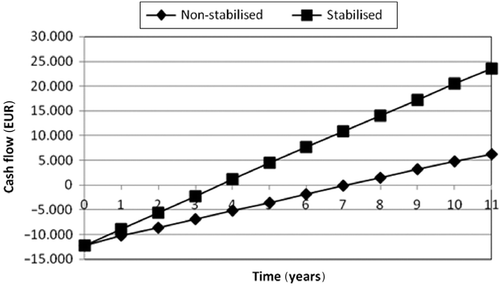
An evaluation of greenhouse gas (GHG) emissions and energy saving due to the conversion of fired to crude brick production was also performed. In the case of fired bricks, GHG emissions and energy consumption are due only to brick firing. Data related to the weight of the bricks produced have been obtained for the down-draught kiln (Greentech Knowledge Solutions, Enzen Global Solutions, University of Illinois, Clean Air Task Force Citation2012), which has a similar efficiency to that of the scove kiln (ILO Citation1984): 2.9 MJ of thermal energy per kg of fired bricks are necessary and 0.282 kg of CO2 are emitted for 1 kg of bricks. For crude bricks, thermal energy consumption and GHG emissions are associated with the production of the electric energy necessary for running the machine, and for stabilised bricks, they are related, in addition, also to the production of the cement added to the dough. An estimation of energy consumption and GHG emissions related to the use of cement was found (PCA Citation2011): 5.47 MJ of thermal energy are necessary and 0.49 kg of CO2 is emitted per kg of cement. Some data related to electricity production are available in the literature (EURELECTRIC Citation2003; WNA Citation2011). Considering a scenario where electric energy is produced mainly by petroleum and coke, 2.5 kJ of thermal energy are consumed and 0.2 g of CO2 are emitted to produce 1 kJ of electric energy. A dry brick density of about 1900 kg/m3 was considered.
Given these hypotheses, Table compares the annual energy consumption and GHG emissions related to crude brick production (both stabilised and non-stabilised) with the same parameters if the same quantity of fired bricks was produced. For both parameters, energy saving higher than 99% and higher than 90% was obtained for non-stabilised and stabilised brick production, respectively.
Table 5 Comparison of annual energy consumption and GHG emissions related to the production of different brick types.
Conclusions
A survey of the fired brick production technology widespread at the handicraft level in the Logone Valley (Chad and Cameroon) was carried out, with a particular emphasis on the environmental impact in terms of GHG emissions and wood fuel consumption.
The possibility of promoting crude earth as building material was examined, starting from a morphological and geotechnical characterisation of local soils to evaluate their suitability to brick production and to identify the best locations for earth extraction.
Subsequently, a new machine for brick extrusion was designed and implemented, optimising its conception to the technological resources available in the Logone Valley, so that it could be reproduced and managed locally. Laboratory tests on bricks produced by the new machine were carried out, showing that extruded crude bricks have good properties when compared with fired bricks used in the Logone Valley.
The machine was replicated in Cameroon and loaned to a local manufacturer for converting his production from fired to crude earthen bricks. Analyses of economic and environmental impacts led to the prediction that the machine will show good performance within 10 years, in terms of the payback period, energy saving and GHG emissions.
Acknowledgements
This study was funded by the European Union within the framework of ACP Science and Technology Programme, a programme of the ACP Group of States. The contents of this publication are the sole responsibility of the authors and can under no circumstances be regarded as reflecting the position of the ACP Secretariat and of the European Union.
Notes
1. ‘Applied research for natural resources valorisation and transformation in a process of fight against poverty in Chad and Cameroon’; subvention: FED/2009/217079; project website: www.valrena.org.
2. Central Africa CFA Franc; 1 EUR = 655.96 XAF.
References
- Achenza, M., and U.Sanna. 2009. Il Manuale Tematico della Terra Cruda. Rome: DEI Tipografia del Genio Civile.
- Alam, S. A., and M.Starr. 2009. “Deforestation and Greenhouse Gas Emissions Associated with Fuelwood Consumption of the Brick Making Industry in Sudan.” Science of the Total Environment407: 847–852. 10.1016/j.scitotenv.2008.09.040.
- Ashour, T., and W.Wu. 2005. “The Influence of Natural Reinforcement Fibers on Erosion Properties of Earth Plaster Materials For Straw Bale Buildings.” Journal of Building Appraisal5 (4): 329–340.
- Ashour, T., H.Georg, and W.Wu. 2011. “An Experimental Investigation on Equilibrium Moisture Content of Earth Plaster with Natural Reinforcement Fibres for Straw Bale Buildings.” Applied Thermal Engineering31: 293–303. 10.1016/j.applthermaleng.2010.09.009.
- ASTM (American Society for Testing and Materials). 2010. “Test Methods for Liquid Limit, Plastic Limit, and Plasticity Index of Soils.” ASTM Standard D4318-10. West Conshohocken, PA: ASTM.
- Casagrande, A.1948. “Classification and Identification of Soils.” Transactions of the American Society of Civil Engineers (ASCE)113: 901–903.
- Dami, A., F. A.Adesina, and N. O.Adeoye. 2010. “The Impact of Drought and Desertification in the Lake Chad Basin Region.” Journal of Environmental Issues and Agriculture in Developing Countries2 (2–3): 92–102.
- Dixon, R. K., P. E.Schroeder, and J. K.Winjum. 1991. Assessment of Promising Forest Management Practices and Technologies for Enhancing the Conservation and Sequestration of Atmospheric Carbon and Their Costs at the Site Level. Washington, DC: US Environmental Protection Agency.
- EURELECTRIC (Union of Electricity Industry). 2003. Efficiency in Electricity Generation. Report July 2003.
- Fall, M.2004. “Traditional Household Energy Sector in Sahelian Countries of West Africa.” In Proceedings of the 2nd World Biomass Conference – Biomass for Energy, Industry and Climate Protection II:2520–2521. Florence: ETA.
- FAO (Food and Agriculture Organization of the United Nations). 2006. World Reference Base for Soil Resources 2006. World Soil Resources Report No. 103. Rome: FAO.
- FAO (Food and Agriculture Organization of the United Nations). 2010. Global Forest Resources Assessment. Rome: FAO.
- Garcia-Carreras, L., and D. J.Parker. 2011. “How Does Local Tropical Deforestation Affect Rainfall?” Geophysical Research Letters38 (L19802): 1–6. 10.1029/2011GL049099.
- Gerneke, G.1992. “The Return to Earth.” Architecture South Africa: Journal of the South African Institute of Architects. March+April (part 1); May+June (part 2); July+August (part 3).
- Greentech Knowledge Solutions, Enzen Global Solutions, University of Illinois, Clean Air Task Force. 2012. Brick Kilns Performance Assessment: a Roadmap for Cleaner Brick Production in India. Paris: UNEP Climate and Clean Air Coalition Publications.
- ILO (International Labour Office). 1984. Small-scale Brickmaking, Technology Series – Technical Memorandum No. 6. Geneva: ILO.
- IPCC (Intergovernmental Panel on Climate Change of the United Nations Environment Programme). 1997. Revised IPCC Guidelines for National GHG Inventories. Inventory Reference Manual. Geneva: IPCC.
- IRRI (International Rice Research Institute). 1985. Wetland Soils: Characterization, Classification, and Utilization. Lagunas: IRRI.
- Myers, N.1989. Deforestation Rates in Tropical Forests and their Climatic Implications. London: Friends of the Earth.
- PCA (Portland Cement Association). 2011. Report on Sustainable Manufacturing. Skokie, IL: PCA.
- Samboré, Y.2004. “The Economic and Socioeconomic Aspects of Wood Energy Systems in Burkina Faso.” In Proceedings of the 2nd World Biomass Conference – Biomass for Energy, Industry and Climate Protection II:2533–2536. Florence: ETA.
- Steyn, D., and G.Bosman. 2010. “The Story of the Great Plans of Mice and Men: Selling Sustainable Earth Construction.” Human Settlements Review1 (1): 196–216.
- UN (United Nations). 2011. World Urbanization Prospects: The 2011 Revision. New York: United Nations.
- Underwood, J. R., and M.Chiuini. 2007. Structural Design: A Practical Guide for Architects. Hoboken, NJ: Wiley.
- UNEP (United Nations Environment Programme). 2008. Destitution, Distortion and Deforestation. The Impact of Conflict on the Timber and Woodfuel Trade in Darfur. Geneva: UNEP.
- WB (The World Bank). 2011. World Development Report. Conflict, Security and Development. Washington, DC: World Bank.
- WNA (World Nuclear Association). 2011. Comparison of Lifecycle Greenhouse Gas Emissions of Various Electricity Generation Sources. Report July 2011. London: WNA.

